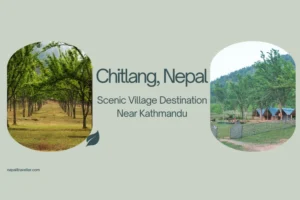The Himalayas are a breathtaking siren for trekkers all over the world, with Nepal’s natural beauty, trails, and culture attracting people to their doors. While treks like Everest and Annapurna Base Camps are often highlighted, the Mardi Himal Trek is the up-and-coming trek to do-more fantastic views, cultural experiences, and less people.
This trek, located in the Annapurna region, can be described as new; it is a shorter trek than most with an astonishingly rewarding trek to the base of Mardi Himal (5587 m), which is east of Machapuchare (Fishtail).
If you are seeking a short, amazing, and spiritual trek, this Ultimate Guide to the Mardi Himal Trek will provide everything you need to know about an incredible trek: how to plan the trek, what you’ll do each day, how to pack, and why this trek should be on your bucket list.
Table of Contents
ToggleWhy the Mardi Himal Trek?
1. Duration
The main appeal of the Mardi Himal Trek is the short duration of both the trek and the time you spend there. The entire Mardi Himal Trek can be done in 5 – 7 days, making it ideal for travelers and trekkers wanting the flexibility to trek in the Himalayas with minimal time commitment of a multi-week trek.
2. Beautiful Views
The trail features unbelievable views of Annapurna South, Hiunchuli, Machapuchare, and Mardi Himal. You will be rewarded with high ridgeline views over the clouds, dense forests and stunning alpine meadows as you reach higher peaks.
3. Off-the-Beaten Path
Mardi Himal provides a more personal, intimate experience for trekkers than Annapurna Base Camp or Everest Base Camp. It is ideal for trekkers seeking peace in their trek, and true experiences with locals.
4. Cultural Interactions
The trek visits Gurung and Magar villages so you can experience Nepalese mountain culture, the customs and hospitality of the Nepalese people. Homestays and tea houses will provide some warmth on your journey.
Trek Overview
- Duration: 5–7 Days
- Max Altitude: 4500 m (Mardi Himal Base Camp)
- Difficulty: Moderate
- Trek Type: Tea House
- Best Time to Visit: March – May and September – November
- Permit Requirements: TIMS Card & ACAP Permit
Best Time to Trek
Spring (March–May)
Spring is one of the best seasons for trekking Mardi Himal. During spring the entire trail opens up with blooming rhododendrons, greenery, and bright blue skies. Temperatures are moderate and visibility is great.
Autumn (September–November)
These are the post-monsoon months where you will find a dry trail with fantastic views. The crisp air and clear skies offer some of the best trekking conditions. The views of the snow-covered peaks are very picturesque and the trails are dry and easy to walk.
Winter (December–February)
Trekking is possible, but the winter months can bring snow and extreme cold weather especially when at high altitude. If you’re an experienced trekker and have the right equipment, you may find the snowy landscapes quite stunning.
Monsoon (June–August)
Not recommended, as the region can receive heavy amounts of rain and usually suffers from slippery trails, leeches, and limited visibility due to cloud cover.
How to Get There
Starting Point: Pokhara
The trek begins from Pokhara, Nepal’s adventure capital. You can fly (25 minutes) or take a bus (6-8 hours) from Kathmandu.
Trailhead Options
Kande: The most popular starting point; approximately a 1.5-hour drive from Pokhara.
Phedi or Dhampus: Alternative starting points with slightly different route variations.
Mardi Himal Trek Itinerary (7 Days)
Day 1: Pokhara to Kande – Trek to Deurali (2,100 m)
- Drive Time: 1.5 hours
- Trek Time: 3-4 hours
- The trail contours through forested areas and terraced fields, providing the first glimpses of Machapuchare.
- Overnight in a teahouse.
Day 2: Deurali to Forest Camp (2,600 m)
- Trek Time: 5-6 hours Today we enter lush rhododendron and oak forests.
- This trek is a beautiful, serene walk through gentle ascents.
- Overnight in a teahouse.
Day 3: Forest Camp to Low Camp (3,050 m)
- Trek Time: 3-4 hours
- The vegetation really thins today, causing the mountains to open up dramatically.
- The iconic fishtail peak starts to dominate the skyline.
- Overnight in a teahouse at Low Camp.
Day 4: Low Camp to High Camp (3,550 m)
- Trek Time: 3-4 hours
- The trek ascends along the ridgeline today becoming more alpine.
- High Camp is just one step away from your final ascent and has breathtaking views.
- Overnight in a teahouse.
Day 5: High Camp to Mardi Himal Base Camp (4,500 m) and back (round trip of 6-7 hours)
- A very early start to catch the sunrise.
- The climb is steep but well worth it!
- The views from the top are breathtaking 360° views of the Annapurna range.
- Return back to High Camp or descend down to Low Camp depending on how you feel based on fitness and time.
Day 6: High Camp to Sidhing Village (1,700 m)
- Trek Time: 5-6 hours
- Trek back down through forest and traditional villages.
- Sidhing has a more rustic, authentic village feel.
- Overnight in a homestay.
Day 7: Drive to Pokhara from Sidhing
- Driving Time: 2-3 hours via jeep or shared vehicle.
Alternate Routes and Extensions
- Australian Camp or Dhampus Extension: Great option if you want more cultural engagement and more time acclimatizing.
- If you have more time, you can combine with Annapurna Base Camp or Poon Hill Trek.
- Finish at Landruk or Ghandruk instead to diversify the views.
Permits
You will need two permits for this trek:
TIMS Card (Trekkers’ Information Management System):
- Cost: NPR 2000 (~$15 USD).
ACAP (Annapurna Conservation Area Permit):
- Cost: NPR 3000 (~$22 USD).
These can either be arranged in Kathmandu or Pokhara via travel agents or the Nepal Tourism Board.
Accommodation and Food
Teahouses
Simple, but comfortable lodges offering basic twin-sharing rooms with warm blankets and shared bathrooms. Limited heating…bring a sleeping bag for warmth.
Food
- Expected standard Nepalese trekking fare:
- Dal Bhat (rice, lentil soup, vegetables)
- Momos (dumplings)
- Chowmein, Pasta, Pancakes
- Tea, coffee and soft drinks
Food therefore becomes significantly more expensive the further you trek due to transport costs.
Packing Essentials
Clothing
- A layered clothing system (base layer, fleece, down jacket, waterproof shell)
- Thermal underwear
- Trekking pants and t-shirts
- A gloves, hat, and sunglasses
Footwear
- Some well worn in trekking boots
- Comfortable sandals (for evening)
- Wool socks
Gear
- A sleeping bag (at least down to -10°C)
- Trekking poles
- A headlamp
- Reusable water bottles and purification tablets
- First Aid kit, sunscreen, and lip balm
Fitness & Difficulty
Mardi Himal Trek is not technically difficult, but there will be some steep climbs (and downhill) between Low Camp and Base Camp. Moderate fitness is adequate. The elevation gain is gradual enough that acclimatization should not be an issue, but hikers need to stay hydrated and listen to their bodies.
Trekking with a guide or without a guide
With a Guide/Porter
- We suggest this for first-time trekkers in Nepal.
- Guides can enhance your overall trekking experience by providing local knowledge and ensuring safety.
- Porters can substantially lighten your load.
Without a Guide
- The trail is easy to follow and can be done alone for previous trekkers.
- GPS and trekking apps (Maps.me, AllTrails) can be helpful.
Cost Summary
- Permits: $~40 USD
- Guide (optional): $25–30/day
- Porter (optional): $20–25/day
- Accommodation: $5–15/night
- Food/Drinks: $20–30/day
- Transport (Pokhara-Kande, Sidhing-Pokhara): $~30
- Estimated Total Cost (7 days): $300–500 USD (budget to mid-range)
Conclusion
The Mardi Himal Trek showcases the best of natural beauty, culture, and adventure in a short time frame. Whether you’re a beginner trekker wanting an easy entry into the Himalayan experience, or a seasoned trekker wanting a quieter adventure away from the main trail, the Mardi Himal Trek will not disappoint.
With stunning views, great local people, and a rewarding trek on a trail almost few know about; this trek is one of the best-kept secrets in Nepal. So, dust off your boots and charge your camera – it’s time to trek the Mardi Himal!






